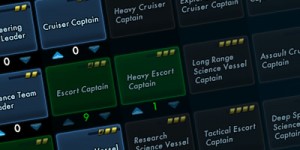 Your captain’s skills are one of the most important aspects of your character in Star Trek: Online, both in terms of how effective you are in combat and in distinguishing your character from others. Although all captains of the same class share the same innate abilities, and all characters have access to the same bridge officer abilities, ships and weapons, how well your character performs with each of those abilities, ships and weapons is primarily determined by your captain’s skills.
Your captain’s skills are one of the most important aspects of your character in Star Trek: Online, both in terms of how effective you are in combat and in distinguishing your character from others. Although all captains of the same class share the same innate abilities, and all characters have access to the same bridge officer abilities, ships and weapons, how well your character performs with each of those abilities, ships and weapons is primarily determined by your captain’s skills.
This article takes a closer look at how the STO skills system works, examines the numbers behind it and discusses some of the implications of both for character progression and skill builds. An understanding of these areas should help you to get the best out of your abilities, ships and weapons and to make informed decisions about how to spend your skill points to create the kind of character you want to play.
Content Summary:
- How Skills Work: Stats and Bonuses
- Examining the Numbers
- Build Implications
- General concepts
- Focus versus flexibility
- Try before you buy
- One for all, not all for one
- Spreading the points in Tier 1
- Avoiding level 8 and 9 in Tier 1 and 2 skills
- Tier 3 skills are your friends
- Looking for overlaps
- Energy weapons – sticking with the basics
- Projectile weapons
- Ship skills and redundancy
- Tier 5 skills
How Skills Work: Stats and Bonuses
Your captain’s skills affect all the other major aspects of your character – your captain’s abilities (whether innate or gained from kits), your bridge officers’ abilities, your ship and your weapons.
The exact effects of your captain’s skills are calculated through a system of stats and bonuses.
Levels to Stats
Your captain has a stat for each skill. The base value of each stat is determined by your captain’s level in the appropriate skill.
You can see these base values on your captain’s Skills tab in the Character Status window by clicking on a skill and looking at the bar chart in the Skill Details window that opens in the lower-right:
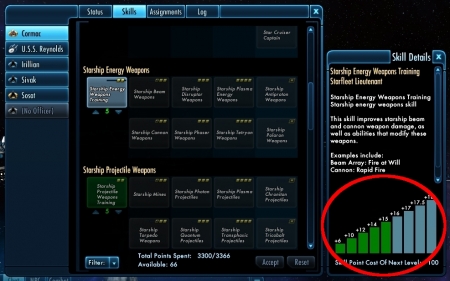
For example, this captain’s Starship Energy Weapons Training-5 gives a base Starship Energy Weapons stat of 15. Increasing the skill to level 6 would increase the stat to 16, and so on.
Note that your captain has skill-based stats for all the skills on his Skills tab, even if he is not yet achieved a high enough rank to spend skill points on them. The base value for a skill-based stat with no levels in the associated skill is 0.
Your captain’s base value for each skill-based stat can be modified by several factors:
- Traits – certain traits apply bonuses to the stats for a specific skill or skills. For example, the Astrophysicist trait gives a permanent +10 bonus to a captain’s Starship Operations Training stat
- Equipment – many items give bonuses to the stats for a specific skill or skills when equipped. For example, starship deflector dishes tend to give bonuses to the stats for skills in the Starship Operations group
- Abilities – several abilities give temporary bonuses to the stats a specific skill or skills when used. For example, the Science Team ability gives a bonus to the Starship Operations Training stat of the target
It’s important to note that the bonus skill-based stats from traits, equipment and ability buffs still apply even if your captain has no levels in the appropriate skill (and thus a base stat of 0).
You can see your captains current stat values, combining the base value from skills and any applicable bonuses, on his Status tab in the Character Status Window, in the Skill-Based Stats: Ground and Skill-Based Stats: Space sections:
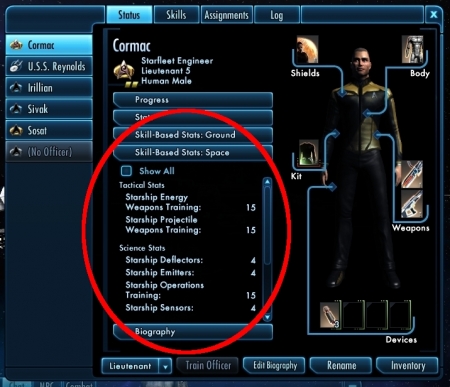
For example, we can see that this captain has a stat of 15 in Starship Energy Weapons Training, Starship Projectile Weapons Training and Starship Operations Training. Note that he also has a stat of 4 in Starship Deflectors, Starship Emitters and Starship Sensors, even though he has no levels in those skills and has not yet reached the rank required to train them, thanks to bonuses from his ship’s current deflector dish item.
Note that you need to be in your ship or on the ground for some stat modifiers to show up on the Status tab.
Stats to Bonuses
Your captain’s current skill-based stats are used to modify the effects of your character’s abilities, ship attributes and weapon damage.
Most abilities, ships and weapons in STO are affected by three skills. In general, the current values of the stats associated with those three skills are added together to form a single stat bonus, and this is applied as a percentage increase to some aspect of the ability, ship or weapon:
- Starship weapons are all affected by three skills. The total stat bonus from all three is applied as a percentage increase to the Standard Issue damage of the weapon. For more details on Standard Issue damage and how weapon damage is calculated, see the Starship Weapons Guide article.
For example, a phaser beam array is affected by the Starship Energy Weapons Training, Starship Beam Weapons and Starship Phaser Weapons stats. A captain with a Starship Energy Weapons stat of 15, a Starship Beam Weapons stat of 22 and a Starship Phaser Weapons stat of 0 will receive a 15+22+0=+37% bonus to the Standard Issue damage of all phaser beam arrays mounted on their ship.
- The majority of both captain and bridge officer space abilities are affected by three skills. The total stat bonus from all three is generally applied as a percentage increase in either the ability’s magnitude or duration (you can find out which by looking at the description of the ability in the Abilities window). With some abilities, only half the stat bonus is applied
For example, the Tachyon Beam space ability is affected by the Starship Operations Training, Starship Deflectors and Starship Deflector Dish stats, and the total stat bonus from all three increases the magnitude – in this case, the amount of shields drained from the target of the ability – as a percentage increase.
- Captain and kit ground abilities generally behave in the same way as space abilities, being affected by three skills, with the total stat bonus from all three increasing the magnitude or duration of the ability
- Bridge officer ground abilities are generally affected only by your captain’s Tactical, Engineering or Science Team Leader stat, according to the class of the bridge officer, and by the bridge officer’s own skill level in the ability. (I suspect that the appropriate Team Leader stat is combined with a stat based on the bridge officer’s own skill level and the total applied as a percentage increase to the ability’s magnitude or duration, but more testing is required to confirm this)
- The speed, turn rate and hull strength of ships are affected by a variable number of skills, depending on the tier of the ship. (Some initial testing suggests that the total stat bonus is applied as a percentage increase to the base speed and turn rate of the ship’s equipped engines, but the relationship between the stat bonus and the hull strength increase remains unclear. Further testing of all these is required)
- Tier 3+ ships are affected by three stats – Starship Command, Escort/Cruiser/Science Vessel Captain (as appropriate) and the appropriate Tier 3-5 Captain stat
- Tier 2 ships are affected by two stats – Starship Command and Escort/Cruiser/Science Vessel Captain (as appropriate)
- I’m not sure whether the Tier 1 Light Cruiser is affected only by the Starship Command stat, or by Starship Command and Cruiser Captain – again, further testing is required
- Certain skills give secondary bonuses to other aspects of your current ship, such as power generation or hull repair rate. (These bonuses definitely seem to be based on the stat value of the appropriate skill and are thus affected by stat bonuses from traits, equipment and abilities, but further testing is required to determine the exact relationships)
Summary
- Most weapons, abilities and ships are affected by three skills
- Your captain has a stat rating for every skill
- The base value of each skilled-based stat is determined by your captain’s level in the associated skill
- The base value of each skill-based stat can be modified by bonuses from traits, equipment and abilities
- When your character uses a weapon, ability or ship, the three skill-based stats for the associated skills are added together to form a stat bonus, which is generally applied as a percentage increase to:
- The base damage of a weapon
- The magnitude or duration of an ability
- The attribute values of a ship
- Some abilities only use half of the stat bonus, and the relationship between the stat bonus and certain ship attributes is currently unclear
- There may be additional modifiers that adjust how much of a stat bonus is applied in some cases, but their exact nature is currently unclear
Examining The Numbers
As explained above, the base value of your captain’s skill-based stats is determined by your captain’s levels in the associated skills.
The stat values for each skill level vary according to the tier of the skill:
| Base Stat Value | |||
| Skill Level | Tier 1 Skill | Tier 2 Skill | Tier 3-5 Skill |
| 0 | 0 | 0 | 0 |
| 1 | 6 | 8 | 10 |
| 2 | 10 | 14 | 18 |
| 3 | 12 | 18 | 24 |
| 4 | 14 | 22 | 30 |
| 5 | 15 | 24 | 36 |
| 6 | 16 | 26 | 40 |
| 7 | 17 | 28 | 44 |
| 8 | 17.5 | 29 | 48 |
| 9 | 18 | 30 | 52 |
The two most important things to recognise here are:
- The stat values for the lower tier skills are lower than the stat values for higher tier skills – in other words, lower tier skills provide smaller bonuses than higher tier skills
- The stat value gained per skill level is subject to a diminishing returns effect – in other words, the higher your level in a skill, the less you gain from increasing its level
The rest of this section is going to spend some time analysing these numbers in various ways, and there will be graphs and more tables. If this kind of thing makes your eyes glaze over, you may want to skip to the next section, which discusses the implications.
Diminishing Returns
As noted above, the stat value gained per skill level is subject to a diminishing returns effect – the first level of a skill increases your captain’s associated stat by more than the second level, and so on. Like the base stat values, the rate at which the stat points gained per level drops off varies according to the tier of a skill:
| Stat Gain/Skill Level | |||
| Skill Level | Tier 1 Skill | Tier 2 Skill | Tier 3-5 Skill |
| 0 to 1 | +6 | +8 | +10 |
| 1 to 2 | +4 | +6 | +8 |
| 2 to 3 | +2 | +4 | +6 |
| 3 to 4 | +2 | +4 | +6 |
| 4 to 5 | +1 | +2 | +6 |
| 5 to 6 | +1 | +2 | +4 |
| 6 to 7 | +1 | +2 | +4 |
| 7 to 8 | +0.5 | +1 | +4 |
| 8 to 9 | +0.5 | +1 | +4 |
For example, going from level 4 to level 5 in a Tier 1 skill only gains you 1 stat point, while going from level 4 to level 5 in a Tier 3-5 skill gains you 6 stat points.
Putting these into the form of a graph makes it easier to see the relationships:
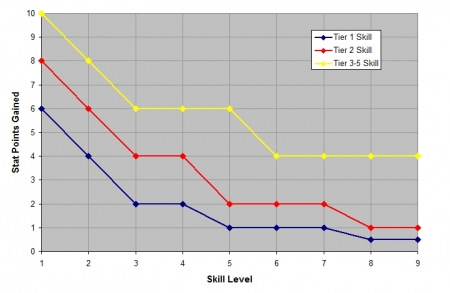
The important things here are that while the returns from Tier 1 and Tier 2 skills drop off at a similar rate, (halving from level 1 to 3, level 4 to 5 and level 7 to 8), Tier 3-5 skills are subject to less of a diminishing returns effect (dropping by about a third from level 1 to 3 and then from level 5 to 6, after which the returns remain constant).
Not only do tier 3+ skills get you a larger bonus overall, then, but they also offer (relatively) more gain per level at higher skill levels.
Stats per Skill Point (Overall)
Of course, although higher tier skills may give bigger bonuses and be less subject to diminishing returns, they also cost more skill points to buy. As will be discussed in greater detail in Build Implications, below, skill points are perhaps your character’s most valuable resource, so it can be useful to consider how much of a bonus you gain from a skill versus how many skill points it costs.
The following table shows the overall ‘value’ of skills by tier, in terms of ’stat points per 100 skill points’ (stat/100SP). The higher this number, the better ‘value’ you’re getting out of your skill points (although it’s worth bearing in mind that this is only one way to consider the ‘value’ of skills – something which will be discussed in the Build Implications section, below).
| Stat/100SP Overall | |||||
| Skill Level | Tier 1 | Tier 2 | Tier 3 | Tier 4 | Tier 5 |
| 1 | 6 | 4 | 3.33 | 2.5 | 2 |
| 2 | 5 | 3.5 | 3 | 2.25 | 1.8 |
| 3 | 4 | 3 | 2.67 | 2 | 1.6 |
| 4 | 3.5 | 2.75 | 2.5 | 1.88 | 1.5 |
| 5 | 3 | 2.4 | 2.4 | 1.8 | 1.44 |
| 6 | 2.67 | 2.17 | 2.22 | 1.67 | 1.33 |
| 7 | 2.43 | 2 | 2.1 | 1.57 | 1.26 |
| 8 | 2.19 | 1.81 | 2 | 1.5 | 1.2 |
| 9 | 2 | 1.67 | 1.93 | 1.44 | 1.16 |
For example, buying level 9 in a Tier 1 skill gives a base stat of 18 and costs a total of 900 skill points, so you’ve gained 2 stat points per 100 skill points spent (2 stat/100SP). Buying level 5 in a Tier 4 skill gives a base stat of 30 and costs a total of 2000 skill points, so you’ve gained 1.5 stat points per 100 skill points spent (1.5 stat/100SP).
Again, putting this into graphical form makes it easier to see the relationships:
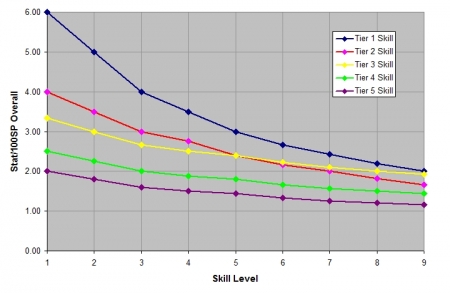
There are quite a few things worth noting here:
- Buying level 1 in a Tier 1 skill is by far the most efficient (in terms of stat points gained for the skill points spent) use of skill points
- Tier 1 skills remain the best ‘overall value’ skills all the way to level 9
- That said, the ‘overall value’ of Tier 1 skills drops much more quickly than higher tier skills, particularly Tier 3+ skills, which maintain a far more constant ‘overall value’
- As such, the difference in ‘overall value’ between skills of different tiers becomes much less pronounced at higher (6+) skill levels
- At a skill level of 5, Tier 3 skills offer just as many stat points per skill point spent as Tier 2 skills
- At skill levels above 5, Tier 3 skills are actually better ‘value’ than Tier 2 skills
- At skill level 9, Tier 3 skills are very nearly as efficient as Tier 1 skills in terms of stat points gained per skill point spent
Stats per Skill Point (by Skill Level)
Another way to consider the ‘value’ or ‘efficiency’ of skills is to look at the stat/100SP ratings for the cost of buying each level of the skill – when going from level 1 to level 2, level 2 to level 3, and so on.
For example, say you like to use phaser beam weapons, and currently have level 5 in the Starship Energy Weapons Training (T1), Starship Beam Weapons (T2) and Starship Phaser Weapons (t3) skills. Your total stat bonus for phaser beam weapons will be 15+24+36 = 75. If you want to increase this stat bonus in the most efficient (in terms of skill points spent per stat point gained) manner, which skill should you raise?
| Stat/100SP by Skill Level | |||||
| Skill Level | Tier 1 | Tier 2 | Tier 3 | Tier 4 | Tier 5 |
| 0 to 1 | 6 | 4 | 3.33 | 2.5 | 2 |
| 1 to 2 | 4 | 3 | 2.67 | 2 | 1.6 |
| 2 to 3 | 2 | 2 | 2 | 1.5 | 1.2 |
| 3 to 4 | 2 | 2 | 2 | 1.5 | 1.2 |
| 4 to 5 | 1 | 1 | 2 | 1.5 | 1.2 |
| 5 to 6 | 1 | 1 | 1.33 | 1 | 0.8 |
| 6 to 7 | 1 | 1 | 1.33 | 1 | 0.8 |
| 7 to 8 | 0.5 | 0.5 | 1.33 | 1 | 0.8 |
| 8 to 9 | 0.5 | 0.5 | 1.33 | 1 | 0.8 |
The answer is Starship Phaser Weapons – not only does raising it from level 5 to level 6 gain you the most stat points (+4, as per the earlier Stat Gain/Skill Level table, bringing your total stat bonus for phaser beam weapons to 79), but it’s also the most efficient option in terms of return on your skill points (buying an extra level in a Tier 3 skill costs 300 SP, so you’re gaining 1.33 stat/100SP).
Buying Level 6 in Starship Energy Weapons Training would only get you +1 stat points for a 100 SP (1 stat/100SP), and buying Level 6 in Starship Beam Weapons would get you +2 stat points for 200 SP (also 1 stat/100SP).
Yes, it’s time for another graph:
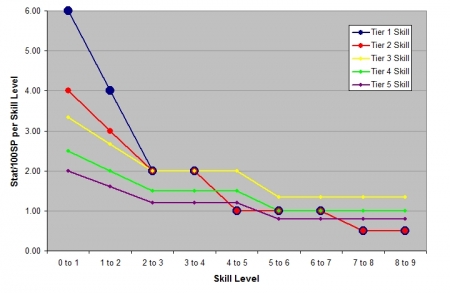
Again, there are several things worth noting here:
- Although Tier 1 and 2 skills offer the best value when buying level 1 or increasing from level 1 to 2, beyond that they quickly become much less efficient
- Tier 1 and 2 skills suffer a big drop in efficiency when going from level 4 to 5 – they are the least efficient of all skills at this step
- Going from level 7 to 8 and level 8 to level 9 in Tier 1 and 2 skills is the least efficient option in the game – even the expensive Tier 5 skills offer a better return on your skill points when buying the last two levels
- Although the first two levels in a Tier 3 skill are less efficient than Tier 1 and 2 skills, buying the third and fourth levels is just as efficient, and at all levels above 4, Tier 3 skills become the most efficient per level
Build Implications
Skill points are perhaps the most important resource in Star Trek: Online. Not only do the skills you purchase with them have a significant impact on your character’s effectiveness with the various weapons, abilities and ships, but the earning and spending of skill points also determines your captain’s progress through the ranks and grades.
As such, they’re a limited resource – at any given rank and grade, your character will only have accumulated a certain number of skill points. In addition, characters currently stop earning skill points once they reach the ‘level cap’ at Admiral-5, so the total number you will have to spend on your captain’s skills is also limited, at least for the time being.
All of which means that deciding what skills to spend your skill points on and how many levels to buy in them – your skills build – are among the most important choices you will make over the course of your captain’s career. The way the skill system works and the numbers behind it have several implications for these decisions that are worth considering.
General Concepts
There are some fundamental aspects of the STO skill system that should be kept in mind whenever thinking about your character’s build, and are worth restating before going any further:
- Tier Structure – skills can be divided into three broad groups according to Tier:
- Tier 1 Skills are cheap to buy (100SP/level) and very general in effect, but provide the lowest base stat values (maximum of 18 at level 9)
- Tier 2 Skills are moderately priced (200SP/level) and more specific in effect, but provide moderate base stat values (maximum of 30 at level 9)
- Tier 3-5 Skills are expensive (300-500 SP/level) and extremely specific in effect, but provide large base stat values (maximum of 52 at level 9)
For example:
- Starship Energy Weapons Training (T1) improves the base damage of all available energy weapons, but only by up to 18%
- Starship Beam Weapons (T2) improves the base damage of beam weapons (about half of the available energy weapons) by up to 30%
- Starship Tetryon Weapons (T4) improves the base damage of tetryon weapons (about a sixth of the available energy weapons) by up to 52%
The way that the skill tiers are structured has several important implications for character progression in STO.
The Tier 1 skills are extremely broad in their application, and nearly all characters will gain some benefit from all of them, regardless of the specific abilities, ship and weapons they are using.
The Tier 2 skills are more narrow in their application, and are where the first significant build decisions need to made. Which categories of ships are you interested in using? Which types of weapons? Which abilities? The answers to these questions will shape which Tier 2 skills you’ll want to train up, and which you can neglect.
The Tier 3-5 skills are all very specific in their application and expensive to buy. However, they also have the biggest impact on your character’s effectiveness. This where you focus your build on the specific abilities, weapons and ships you wish your character to excel in.
- Three is the Magic Number – all space weapons, Tier 3+ ships and the vast majority of abilities are affected by the stats associated with three skills – one from Tier 1, one from Tier 2 and one from Tier 3-5.
For example, the base damage of a Tetryon Beam Array is increased by the Starship Energy Weapons Training (T1), Starship Beam Weapons (T2) and Starship Tetryon Weapons (T4) stats.
The most obvious consequence of this is that the maximum stat bonus your character can gain for most abilities, weapons or ships from skills alone is 100 – 18 from the Tier 1 skill, 30 from the Tier 2 skill and 52 from the Tier 3-5 skill. It’s worth noting that over half of these stat points come from the Tier 3-5 skill.
It can be helpful to get into the habit of thinking about your character’s skills in terms of these ’skill chains’ rather than individual skills, especially when considering where to spend skill points most effectively.
- Diminishing Returns – each level of a skill costs the same number of skill points, but the higher your level in a skill, the less you gain from increasing its level
For example, buying level 1 in a Tier 2 skill costs 200 skill points and will increase your captain’s base stat for that skill by 8 (from 0 to 8). Going from level 7 to level 8 in a Tier 2 skill also costs 200 skill points, but will increase your captain’s base stat from that skill by a mere 1 point (from 28 to 29).
As skill points are a limited resource, this is perhaps the single most important aspect of the skills system to consider when choosing where to spend them. Many of the points discussed in the rest of this section revolve around this concept, and will examine it in more detail.
Focus versus Flexibility
The natural tendency when spending your skill points is to try and ‘max’ as many skills to level 9 as possible. Indeed, if you want to squeeze every last drop of performance out of an ability, ship or weapon, going ‘9/9/9′ – buying level 9 in all three skills in its ’skill chain’ – is the way to do it. However, there are a couple of important issues with this approach:
- Because of the diminishing returns on higher skill levels, it’s not a very efficient way to spend your skill points
- Because skill points are limited, you can’t max very many skills, especially the Tier 3-5 ones that provide the biggest base stat values
The combination of these two issues tends to lead the ‘all 9s’ approach into very specialised builds that are very good at a small number of things. Often these builds end up focussed on one Tier 5 ship with a specific weapon load-out, generally with a limited range of abilities that can be used effectively, and frequently neglecting ground combat almost entirely.
There’s nothing inherently wrong with this kind of build – if planned carefully they can be extremely effective in their chosen areas of speciality, which has obvious benefits, especially in PvP. However, they sacrifice a considerable degree of flexibility for a relatively small gain in performance in a narrow range of areas.
On the other hand, if you prefer having more options – being able to switch out different bridge officers with different abilities according to the situation while maintaining good performance with both, for example, or having a better balance between space and ground skills – it’s possible to gain a considerable degree of flexibility by sacrificing a relatively small amount of performance by spending skill points more efficiently.
A couple of general examples:
Consider abilities, weapons and ships with ’skill chains’ of Tier 1, Tier 2 and Tier 3 skills, such as Tachyon Beam, the ‘Emergency Power to… <system>’ abilities and phaser or photon weapons. Going 9/9/9 in the skills associated with one of these costs 5,400 SP and gives a stat bonus of 100. Alternatively, going 6/6/6 costs 3,600 SP and gives a stat bonus of 82. In other words, you can get three 82 stat bonuses for the same cost as two 100 stat bonuses. That’s 246 total stat points for the same cost as 200. (In fact, if you go 5/5/7, you can get an 83 bonus in each, making 249 stat points for the cost of 200.)
With abilities, weapons or ships that have the same Tier 1 or Tier 2 skills in their ’skill chain’, you can get more flexibility for even less loss in performance. For example, Starship Energy Weapons Training-9, Starship Beam Weapons-9 and Starship Phaser Weapons-9 costs 5,400 SP and gives a stat bonus of 100 with phaser beam weapons and 70 with phaser cannon weapons. For the same 5,400 SP, you could buy Starship Energy Weapons Training-7, Starship Beam Weapons-5, Starship Cannon Weapons-5 and Starship Phaser Weapons-9, for a 93 stat bonus with both phaser beams and phaser cannons.
Taking a little time to look at the numbers that the STO skills system is based on and avoiding the urge to try and max every skill, then, can help you make the most of the limited skill points you have available. Here are a few more things to consider:
Try Before You Buy
It’s worth remembering that you don’t need levels in the skills that affect abilities, ships and weapons to use them. It’s generally a good idea to try things out for a mission or two before making the decision to invest skill points in their associated skills. Sometimes abilities that sounded very cool don’t turn out to be as useful as you’d expect, and vice versa.
One for All, Not All for One
Whatever skills you decide you wish to invest in, the diminishing returns on stat points gained per skill level means that as you progress through the game, your character will gain more immediate benefit from raising them all gradually, rather than focussing on one at a time.
For example, say there are five Tier 1 skills you wish to buy, and you have 500 unspent skill points. If you invest all 500 SP in one of the skills, your character will have a stat of 15 in that skill, and 0 in the other four. If you invest 100 SP in each skill, your character will immediately gain a stat of 6 in all five skill.
So, it makes sense to split your skill points among the skills you want and raise them all gradually.
Spreading the Points in Tier 1
A Lieutenant captain must spend 6700 skill points in order to earn a promotion to Lt Commander, and all of these have to go on Tier 1 skills, of which there are 11 to choose from (9 common to all characters, and 2 unique to your captain’s class).
- If you succumb to the urge to max skills, you can afford level 9 in 7 skills and level 4 in one more. In total, that will give you 140 stat points from your Tier 1 skills
- If you spread the points more evenly, you can afford level 6 in 10 skills and level 7 in another, or level 7 in 6 skills and level 5 in 5 skills, either of which gives a total of 177 stat points
The very general nature of the Tier 1 skills only goes to make spreading the points an even better option. Between them, these skills apply to almost every ability, ship and space weapon your character will ever use, so having stats of 15-17 in all of them gives you a much better foundation than having 18 in less than two-thirds of them.
Avoiding Level 8 and 9 in Tier 1 and 2 Skills
Buying level 8 or 9 in Tier 1 and 2 skills is the least efficient use of skill points on a level-by-level basis in STO, gaining you only 0.5 stat points per 100 SP spent. It also makes only a minimal difference to your stat bonuses – having 9/9/9 in a skill chain gives you a total stat bonus of 100. Having 7/7/9 gives you a total stat bonus of 97 and 600 SP to spend elsewhere.
Tier 3 Skills Are Your Friends
On the other hand, buying level 5 and above in Tier 3 skills is the most efficient use of skill points on a level-by-level basis, gaining you 2 stat points per 100 SP spent when buying level 5, and 1.33 stat points per 100 SP spent when buying every level above that. It also makes a big difference in stat bonuses – buying level 5 in a Tier 3 skill gains you 6 stat points, and every level above that gains you 4 more.
As such, abilities and weapons whose skill chains end with a Tier 3 skill, like Tachyon Beam, the ‘Emergency Power to… <system>’ abilities and phaser or photon weapons, are always worth considering. Getting high stat bonuses with abilities, ships and weapons whose skill chain ends with a Tier 4 or 5 skill not only costs more SP overall, it’s also less efficient in terms of stat points per SP spent. Of course, many of those abilities and ships are more powerful, so it’s not always a simple decision.
Looking for Overlaps
When deciding which abilities, ships and weapons to invest your skill points in, pay attention to any ‘overlaps’ in their skill chains – skills that affect more than one of the options you’re considering.
For example, the Science Team ability is boosted by the Science Team Leader (T1), Starship Deflectors (T2) and Starship Deflector Field (T4) stats, while Tachyon Beam is boosted by the Starship Operations Training (T1), Starship Deflectors (T2) and Starship Deflector Dish (T3) stats. As both abilities are boosted by Starship Deflectors (T2), any skill points you invest in that skill (and any items you equip that provide bonuses to it) will boost the effectiveness of both abilities.
Overlapping skill chains help you get more out of your limited skill points by getting more benefit from a single skill, and are worth paying attention to when deciding which abilities, weapons and ships to use.
(Note that overlaps of Tier 1 skills are extremely common, as the Tier 1 skills are so general in application. However, they’re less valuable than overlaps in Tier 2 or Tier 3-5 skills, as Tier 1 skills offer the smallest bonuses.)
Energy Weapons – Sticking With The Basics
Beyond personal preference or ‘coolness’ factor, there are currently precious few good reasons to use any of the more advanced energy weapon types (plasma, tetryon, antiproton, polaron). The only real difference between the different energy weapon damage types is in their special effects, which generally have a small chance to be applied per attack. Their base damage and DPS are all the same.
As phasers and disruptors have their damage boosted by Tier 3 skills (Starship Phaser Weapons and Starship Disruptor Weapons) while the more advanced types are boosted by more expensive and less efficient Tier 4 and 5 skills, you’ll get a better return on on your skill points from sticking with the basics.
The only potential advantages I can see from choosing to specialise in one of the more advanced types are:
- In PvP, opponents may be more likely to have equipped their ships with phaser or disruptor damage resistance, as these two damage types are more commonly used (thanks to the lower cost and higher efficiency of their associated skills).
- In high level and end game PvE, it’s possible that enemy ships may have higher resistances to phaser and disruptor damage than the other types – but we’ll have to wait and see when Cryptic starts adding the first end game content
Projectile Weapons
There’s more variation between the different projectile weapon damage types than the energy weapon types – their damage and recharge varies significantly, and their special effects are generally applied on every attack. As such, while photons and quantums still have the advantage of being boosted by Tier 3 skills, picking one of the more advanced types (plasma, transphasic, chroniton, tricobalt) to focus on is a more valid choice, according to your ship and playstyle.
If in doubt, though, photon and quantum are the most efficient options, in terms of return on your skill points.
Ship Skills and Redundancy
The Tier 1 Starship Command skill applies to all ships, and the Tier 2 Escort/Cruiser/Science Vessel Captain skills apply to all ships of the appropriate category. However, the Tier 3-5 skills only apply to the specific ship in their name.
The upshot of this is that, if you intend to upgrade to the next Tier of ships as soon as possible, the Tier 3 and 4 Captain skills will become redundant when you are promoted. As such, you may want to avoid investing valuable skill points into any of these skills.
(The exception to this are some of the escort skills, which also boost the effectiveness of certain Tactical abilities, and thus can be useful even when not commanding the appropriate ship type.)
Tier 5 Skills
At present, your captain will stop earning skill points when you reach the current ‘rank cap’ of Admiral-5. This means that the only skill points you’ll have to spend on Tier 5 skills are those you earn between being promoted to Admiral (which unlocks the Tier 5 skills) and hitting Admiral-5 – a total of 8,000 SP.
As Tier 5 skills costs 500 SP/level, 8,000 SP translates into 16 skill levels, which isn’t a lot. If you succumb to the siren call of the 9s, you’ll be able to max one Tier 5 skill and get another to level 7, for a total of 96 stat points (52 from the level 9 skill and 44 from the level 7).
Although Tier 3-5 skills are less subject to diminishing returns than Tier 1 and Tier 2 skills, you will still get more gain in total stat points by spreading your 8,000 SP between more skills. Buying 4 Tier 5 skills to level 4, for example, nets you 120 stat points in total (30 for each skill). Of course, whether you wish to improve several abilities, ships and weapons that are affected by Tier 5 skills by a smaller amount or focus on larger bonuses for just a couple is up to you, but it’s worth considering the options.
It’s also worth noting that Cryptic has already stated that it has plans to increase the rank cap, the skill point cap or both at some point, so you’re unlikely to be limited to 8,000 SP in Tier 5 skills forever.
—
If you want to test your skills and build your character in advance so you don’t have to respec, try STO Planner, the prettiest Star Trek Online character skills builder.
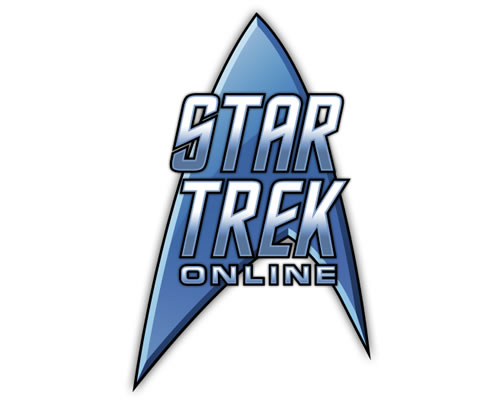
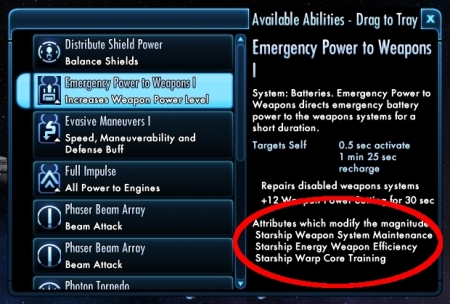
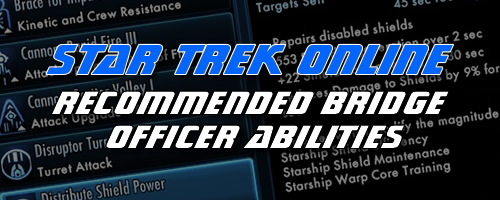
Thanks, for all your work. This information will help me out a lot. I plan on telling others of this page.
To the writer of this article could you please review my Character Plan and let me know how I did. If you think I did a good or horrible job please let me know I will not be offend. Please let me know where I went wrong.
http://quutar.110mb.com/stoplanner/STOPlanner.html?STOPCode=0;2;0;3,18,40,44;00000647067666660000000055005505550555500000050050055055055605000000050500565005660000000000000000040400404000000000000000755
Sorry Revised it a little
http://quutar.110mb.com/stoplanner/STOPlanner.html?STOPCode=0;2;0;3,18,40,44;00000647067666660000000055005505550555500000050070060067060606000000060700666000660000000000000000040400404000000000000000757
As far as I know Heavy Cruiser Captain and Exploration Cruiser Captain don’t do anything for T5 ships, so once you have a Star Cruiser/Assault Cruiser those skills won’t increase anything. I’m not 100% sure and it might already be changed but it wasn’t working last time I checked.
I’m not an expert though so don’t know what advice I can give about other skills: I depends what weapons and bridge officer abilities you like I guess.
According to the in game notes 25% goes into the higher class ship
Why make a page with content not your own ?
The original writer has done a superb job, you might give him more credit as you do, and do you have permission to copy? ill inform him of this.
Dude,
This rocks. Excellent work. Any chance of an update now that Season 3 has just been released? Are there any new skills, game mechanics etc that are relevant here?
Zebitty.